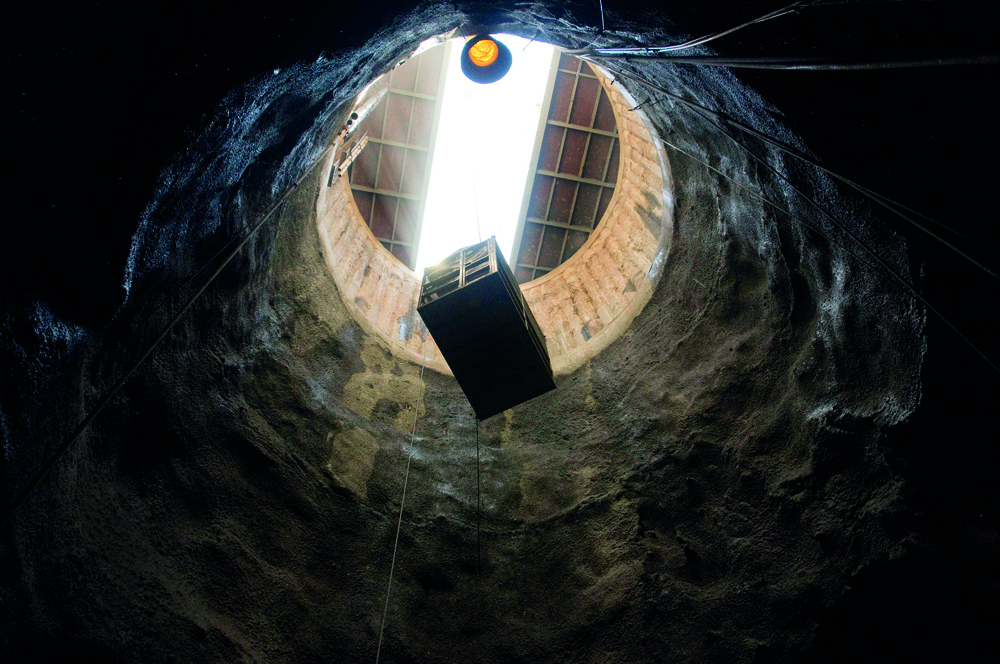Tunnel Vision
A new exhibition about New York’s underground earth works reveals a quasi-mythological mirror image of the city
A new exhibition about New York’s underground earth works reveals a quasi-mythological mirror image of the city

‘Stocks Dive’, ‘Prices Plunge’, ‘Markets Plummet’. We’re in the midst of a declension, an Icarean moment in time when aspirations turn vertiginous and ladders become snakes. A new exhibition in New York suggests that perhaps there is some kind of life beneath the cold asphalt rushing up to meet us. ‘The Future Beneath Us’, currently on show at the New York Transit Museum Gallery Annex, and at the Science, Business and Industry Library, speaks of a mirror city to New York, a benighted, unglamorous metropolis of dark shafts and damp thoroughfares in which air is hewn out of rock, rather than rock heaped into air. It paints this portrait quite accidentally while describing the eight massive subterranean construction projects currently taking place deep beneath the city’s surface.
The simultaneous creation of a thicket of tunnels, hubs and work plants has seemingly resulted in an alter-city being formed, a sunless empire hidden entirely from the view of most of the city’s denizens. Chief among the projects is the gargantuan Water Tunnel No. 3, one of the largest engineering projects in the world. It has a diameter of seven metres, stretches for almost 100 kilometres, and reaches depths beneath the city of over 250 metres, as deep as the Chrysler building is high. It is a work of monumental size and beauty, a gargantuan concrete tube laid down amidst a glistening backdrop of quartzofeldspathically-banded garnetiferous muscovite-biotite schist. The only shame is that it will never be seen. Its entombment is part of its creation. It is a true earth work.
Such colossal underground structures have traditionally been the domain of morlocks and mole people, both antitheses of civilization and its warped reflection. Here too in New York there is something of this. The tunnels are created by ravenous giant leech-like boring machines with ever-spinning circular jaws, which are, in turn, operated by thick-skinned workers known as sandhogs. Compounding the feeling of a subculture beneath the substrata is the fact that many of the sandhogs are second or third generation tunnel workers, their forefathers having worked, and sometimes died, on Water Tunnels Nos. 1 and 2. A popular sandhog saying, ‘If it’s deeper than the grave, the sandhogs dug it’, further stresses the quasi-mythological elements of this underworld: for what is deeper than the grave but Hades itself? It comes as little surprise that the robotic submarine used to explore the city’s existing water tunnels is known as Persephone.
Not that such a ghastly reading of the project is anywhere present in what is a strictly civic exhibition. With a beady eye on the vast stimulus packages set to be thrown at public works across the country, the show seemed more interested in attempting to instill its subjects with a whiff of New Deal human triumphalism. In this it appears a little misguided. The time-span allotted to these projects is less human than geological in nature. Work on Water Tunnel No. 3 began in 1969 and is not expected to finish until 2020. The Second Avenue Subway was first proposed in 1920, and has been under construction since 1972. The Croton Water Filtration Plant has been mooted since 1890. If any kind of memorial to the human spirit is being created beneath the city proper it is not a triumph of the common man over economic adversity but rather a fossil kingdom of public policy.
Indeed while the utility of these works is unquestionable, history would suggest that not even usefulness is a necessary feature for the creation of triumphant public works. Take the story of Joseph Williamson, a tobacco merchant from Liverpool, who, in the early 19th century, began employing hundreds of workers in the Edge Hill area of the city to build a series of secret subterranean passages and huge underground halls beneath the streets. In the words of Charles Hand, President of the Historic Society of Lancashire and Cheshire, and a fairly early (1916) explorer of Williamson’s creation, the construction was: ‘a nightmare maze of constructed tunnels and caves. Nobody knows their extent. They are grotesque beyond description … dungeons carved out of the solid rock with no light and no ventilation … all apparently without the slightest objective or motive.'
The reasons for the creation of Williamson’s tunnels have been much debated. Some suggest that he was a member of an extremist religious sect and that the tunnels were built to provide refuge for himself and his friends come the Day of Judgment. Others propose they were used to smuggle contraband to and from Liverpool’s port. Yet amidst all the conspiratorial chatter, Williamson’s insistence that he had them built purely for ‘the employment of the poor’ rings truest. Over 130 years before the New Deal and its mass employment programmes sought to revivify a country, Williamson instigated a one-man philanthropic Works Progress Administration, making sure his workers ‘all received a weekly wage and were thus enabled to enjoy the blessing of charity without the attendant curse of stifled self-respect’. Unbounded by usefulness, created purely to relieve unemployment, his tunnels are the epitome of an economic stimulus, suggesting that during dark times, to seek the light at the end of the tunnel, you first need to build one.























